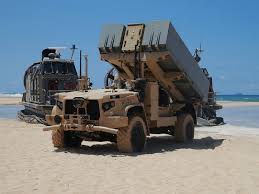Navy-Marine Expeditionary Ship Interdiction System:

Philippines recently confirmed the deployment of US anti-ship missile system NMESIS for this year’s Balikatan military exercises.
- It is an anti-ship missile system developed for the US Marine Corps (USMC) to support land-to-sea attacks performed by the US Navy.
- It features the US Navy’s latest anti-ship missile, the Naval Strike Missile (NSM), mounted atop the chassis of an unmanned variant of the Oshkosh Joint Light Tactical Vehicle (JLTV).
- The ground vehicle platform, known as Remotely Operated Ground Unit for Expeditionary (ROGUE) Fires vehicle, is supplied by Oshkosh Defense, United States, while the NSM is jointly manufactured by Raytheon Missiles & Defense (Raytheon), United States, and Norwegian company Kongsberg Defence & Aerospace.
- NMESIS is not considered an autonomous launcher, as its fire control system is not controlled by the self-driving system and autonomy technology.
- The system is operated by a marine who is responsible for mission planning and firing of the missile.
- It is a multi-mission cruise missile that can ably neutralise highly secure maritime and land targets.
- The missile can destroy enemy ships located more than 100 nm (185 km) away.
- Equipped with an advanced seeker, it provides high-precision capabilities.
- The missile can escape enemy radars by performing manoeuvres and flying close to sea level.
- It carries a 226.79 kg-class warhead and programmable fuse.




